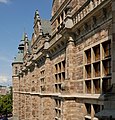Nordic Museum

The Nordic Museum (Nordiska museet) is located on the island of Djurgården in Stockholm and is responsible for the presentation of the cultural history and ethnic groups in Sweden . The oldest exhibits date from around the beginning of the 16th century.
history
The museum was founded at the end of the 19th century by Artur Hazelius , who was also responsible for opening the Skansen open-air museum . The Nordic Museum started as a Scandinavian ethnographic collection in a house on Drottninggatan in Stockholm . In 1880 the collection was renamed "Nordic Museum" and became a foundation of the Swedish people.
construction
Part of the museum opened in 1897 with the Stockholm Art and Industry Exhibition . In 1907 the museum moved into the current building. The building by the architect Isak Gustaf Clason in the Renaissance style is particularly striking because of its large central hall. This is 125 m long and 24 m high. At its center is a six-meter-high, polychrome wooden statue by the sculptor Carl Milles , which depicts King Gustav Wasa seated on his throne. Since 1971 the building has been under monument protection as Byggnadsminne .
activities
The Nordic Museum shows permanent and changing exhibitions on customs and traditions of the country as well as fashion, national costumes, folk art, toys, furnished rooms with set tables and everyday objects from then and now, paintings by August Strindberg as well as photographs and cameras. There are currently around 1.5 million items in the collections and around 250,000 books in the scientific library. The Nordic Museum also owns and manages a number of castles and manors such as Tyresö Castle , Svindersvik and Julita gård .
Picture gallery
Web links
- Nordic Museum website
- Entry in the bebyggelseregistret des Riksantikvarieämbetet (Swedish)
Coordinates: 59 ° 19 ′ 45 ″ N , 18 ° 5 ′ 36 ″ E







